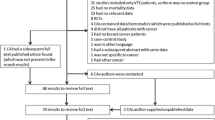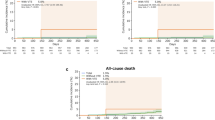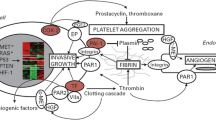Abstract
Purpose
To date, there is no universally acceptable risk assessment tool in clinical practice that accurately estimates the risk of venous thromboembolism (VTE) in patients with breast cancer, despite the large number of published studies. Thus, the aim of this narrative review was to summarize the most relevant risk factors for VTE in these patients.
Methods
We searched Ovid Embase and Ovid MEDLINE, from inception to March 26, 2021, to identify all articles that focused on breast cancer and multiple thromboembolic diseases. We also searched the references section of relevant articles to identify studies. We did not include case reports or case series with small sample size, N < 20.
Results
VTE in patients with breast cancer was strongly associated with patient-, tumor-, and non-tumor-related risk factors, such as age, disease stage, central catheter placement, and chemotherapy and tamoxifen use, especially within 2 years of breast cancer diagnosis. CDK inhibitors are emerging factors that may also increase the risk of VTE.
Conclusions
The risk of VTE in patients with breast cancer depends on various patient-, tumor-, and non-tumor-related risk factors. Identifying these risk factors during breast cancer diagnosis and treatment is essential in developing a practical dynamic predictive tool that can help individualize strategies to prevent VTE.
Similar content being viewed by others
Availability of data and materials
Not applicable.
Code availability
Not applicable.
References
Walker AJ, Card TR, West J, Crooks C, Grainge MJ (2013) Incidence of venous thromboembolism in patients with cancer–a cohort study using linked United Kingdom databases. Eur J Cancer 49(6):1404–1413
Khorana AA, Francis CW, Culakova E, Fisher RI, Kuderer NM, Lyman GH (2006) Thromboembolism in hospitalized neutropenic cancer patients. J Clin Oncol 24(3):484–490
Paneesha S, McManus A, Arya R, Scriven N, Farren T, Nokes T et al (2010) Frequency, demographics and risk (according to tumour type or site) of cancer-associated thrombosis among patients seen at outpatient DVT clinics. Thromb Haemost 103(02):338–343
Khan UT, Walker AJ, Baig S, Card TR, Kirwan CC, Grainge MJ (2017) Venous thromboembolism and mortality in breast cancer: cohort study with systematic review and meta-analysis. BMC Cancer 17(1):1–13
Rebouças D, Costa M, Thuler L, Garces A, Aquino L, Bines J (2016) Breast cancer-associated venous thromboembolism: a case–control study. The Breast 28:84–88
Shai A, Rennert HS, Lavie O, Ballan-Haj M, Bitterman A, Steiner M et al (2014) Statins, aspirin and risk of venous thromboembolic events in breast cancer patients. J Thromb Thrombolysis 38(1):32–38
Walker AJ, West J, Card TR, Crooks C, Kirwan CC, Grainge MJ (2016) When are breast cancer patients at highest risk of venous thromboembolism? A cohort study using English health care data. Blood J Am Soc Hematol 127(7):849–857
Brand JS, Hedayati E, Bhoo-Pathy N, Bergh J, Hall P, Humphreys K et al (2017) Time-dependent risk and predictors of venous thromboembolism in breast cancer patients: a population-based cohort study. Cancer 123(3):468–475
Chavez-MacGregor M, Zhao H, Kroll M, Fang S, Zhang N, Hortobagyi G et al (2011) Risk factors and incidence of thromboembolic events (TEEs) in older men and women with breast cancer. Ann Oncol 22(11):2394–2402
Clahsen PC, Van de Velde C, Julien J-P, Floiras J-L, Mignolet FY (1994) Thromboembolic complications after perioperative chemotherapy in women with early breast cancer: a European Organization for Research and Treatment of Cancer Breast Cancer Cooperative Group study. J Clin Oncol 12(6):1266–1271
Saphner T, Tormey D, Gray R (1991) Venous and arterial thrombosis in patients who received adjuvant therapy for breast cancer. J Clin Oncol 9(2):286–294
Onitilo AA, Doi SA, Engel JM, Glurich I, Johnson J, Berg R (2012) Clustering of venous thrombosis events at the start of tamoxifen therapy in breast cancer: a population-based experience. Thromb Res 130(1):27–31
Hernandez RK, Sørensen HT, Pedersen L, Jacobsen J, Lash TL (2009) Tamoxifen treatment and risk of deep venous thrombosis and pulmonary embolism: a Danish population-based cohort study. Cancer 115(19):4442–9
Kovac M, Kovac Z, Tomasevic Z, Vucicevic S, Djordjevic V, Pruner I et al (2015) Factor V Leiden mutation and high FVIII are associated with an increased risk of VTE in women with breast cancer during adjuvant tamoxifen—results from a prospective, single center, case control study. Eur J Intern Med 26(1):63–67
Mandalà M, Curigliano G, Bucciarelli P, Ferretti G, Mannucci P, Colleoni M et al (2004) Factor V Leiden and G20210A prothrombin mutation and the risk of subclavian vein thrombosis in patients with breast cancer and a central venous catheter. Ann Oncol 15(4):590–593
Tan L, Sun Y, Zhu L, Lei X, Liang D, Rao N et al (2019) Risk factors of catheter-related thrombosis in early-stage breast cancer patients: a single-center retrospective study. Cancer Manag Res 11:8379
Kang J, Sun W, Li H, Ma E, Wang K, Chen W (2016) Peripherally inserted central catheter-related vein thrombosis in breast cancer patients. J Vasc Access 17(1):67–71
Debourdeau P, Espié M, Chevret S, Gligorov J, Elias A, Dupré PF et al (2017) Incidence, risk factors, and outcomes of central venous catheter-related thromboembolism in breast cancer patients: the CAVECCAS study. Cancer Med 6(11):2732–2744
Eggemann H, Bernreiter A-L, Reinisch M, Loibl S, Taran F-A, Costa S-D et al (2019) Tamoxifen treatment for male breast cancer and risk of thromboembolism: prospective cohort analysis. Br J Cancer 120(3):301–305
Faiz A, Guo S, Kaveney A, Philipp C (2018) Venous thrombosis and breast cancer in older women: racial differences in risk factors and mortality. Thromb Res 171:130–135
Chew HK, Wun T, Harvey DJ, Zhou H, White RH (2006) Incidence of venous thromboembolism and the impact on survival in breast cancer patients. J Clin Oncol 25(1):70–76
Ording AG, Horváth-Puhó E, Garne JP, Nyström PW, Vyberg M, Sørensen HT, Lash TL (2014) Impact of comorbidity on risk of venous thromboembolism in patients with breast cancer: a Danish population-based cohort study. BMJ Open 4(6):e005082
West MT, Smith CE, Kaempf A, Kohs TC, Amirsoltani R, Ribkoff J et al (2021) CDK 4/6 inhibitors are associated with a high incidence of thrombotic events in women with breast cancer in real-world practice. Eur J Haematol 106(5):634–642
Hoy J, Neeman T, Stuart-Harris R, Davis A (2009) Risk of venous thromboembolism in patients receiving adjuvant chemotherapy with 5-fluorouracil, epirubicin and cyclophosphamide for early breast cancer. Asia Pac J Clin Oncol 5(2):129–36
Pritchard KI, Paterson A, Paul NA, Zee B, Fine S, Pater J (1996) Increased thromboembolic complications with concurrent tamoxifen and chemotherapy in a randomized trial of adjuvant therapy for women with breast cancer. National Cancer Institute of Canada Clinical Trials Group Breast Cancer Site Group. J Clin Oncol 14(10):2731–7
Tippit D, Siegel E, Ochoa D, Pennisi A, Hill E, Merrill A et al (2018) Upper-extremity deep vein thrombosis in patients with breast cancer with chest versus arm central venous port catheters. Breast Cancer 12:1178223418771909
Momeni A, Fox JP (2018) Venous thromboembolism after surgical treatment of breast cancer. Ann Plast Surg 80(2):188–192
Garber JE, Halabi S, Tolaney SM, Kaplan E, Archer L, Atkins JN et al (2010) Factor V Leiden mutation and thromboembolism risk in women receiving adjuvant tamoxifen for breast cancer. J Natl Cancer Inst 102(13):942–949
Brand JS, Hedayati E, Humphreys K, Ludvigsson JF, Johansson AL, Bergh J et al (2016) Chemotherapy, genetic susceptibility, and risk of venous thromboembolism in breast cancer patients. Clin Cancer Res 22(21):5249–5255
Ferroni P, Roselli M, Riondino S, Cavaliere F, Guadagni F (2016) Insulin resistance as a predictor of venous thromboembolism in breast cancer. Endocr Relat Cancer 23:L25-8
Lin HF, Liao KF, Chang CM, Lin CL, Lai SW, Hsu CY (2018) Correlation of the tamoxifen use with the increased risk of deep vein thrombosis and pulmonary embolism in elderly women with breast cancer: a case–control study. Medicine 97(51)
Goodnough LT, Saito H, Manni A, Jones PK, Pearson OH (1984) Increased incidence of thromboembolism in stage IV breast cancer patients treated with a five-drug chemotherapy regimen. Cancer 54(7):1264–1268
The A (2002) Anastrozole alone or in combination with tamoxifen versus tamoxifen alone for adjuvant treatment of postmenopausal women with early breast cancer: first results of the ATAC randomised trial. The Lancet 359(9324):2131–2139
Nolan L, Darby A, Boleti K, Simmonds P (2011) The incidence of symptomatic thromboembolism in patients receiving adjuvant anthracycline-based chemotherapy for early stage breast cancer. The Breast 20(2):151–154
Xu X, Chlebowski RT, Shi J, Barac A, Haque R (2019) Aromatase inhibitor and tamoxifen use and the risk of venous thromboembolism in breast cancer survivors. Breast Cancer Res Treat 174(3):785–794
Kirwan CC, Mcdowell G, Mccollum CN, Byrne GJ (2011) Incidence of venous thromboembolism during chemotherapy for breast cancer: impact on cancer outcome. Anticancer Res 31(6):2383–2388
Pannucci CJ, Chang EY, Wilkins EG (2009) Venous thromboembolic disease in autogenous breast reconstruction. Ann Plast Surg 63(1):34–38
Thein KZ, Htut TW, Ball S, Swarup S, Sultan A, Oo TH (2020) Venous thromboembolism risk in patients with hormone receptor-positive HER2-negative metastatic breast cancer treated with combined CDK 4/6 inhibitors plus endocrine therapy versus endocrine therapy alone: a systematic review and meta-analysis of randomized controlled trials. Breast Cancer Res Treat 183(2):479–487
Gervaso L, Montero AJ, Jia X, Khorana AA (2020) Venous thromboembolism in breast cancer patients receiving cyclin-dependent kinase inhibitors. J Thromb Haemost 18(1):162–168
Acknowledgements
The authors thank Kate Krause in the Research Medical Library at The University of Texas MD Anderson Cancer Center for her assistance with the literature review. The authors also thank Ann Sutton, Scientific Editor, and Ashli Nguyen-Villarreal, Associate Scientific Editor, in the Research Medical Library at The University of Texas MD Anderson Cancer Center, for editing this article.
Author information
Authors and Affiliations
Contributions
ZR: design, writing, literature search, and review. NA: writing and review. VN: writing. CE: design, writing, and review.
Corresponding author
Ethics declarations
Ethics approval
Not applicable.
Consent to participate
Not applicable.
Consent for publication
We provide a consent for the Journal of Supportive Care in Cancer to publish this manuscript.
Conflict of interest
The authors declare no competing interests.
Additional information
Publisher's Note
Springer Nature remains neutral with regard to jurisdictional claims in published maps and institutional affiliations.
Appendices
Appendix
METHODS SECTION
We searched the Ovid Embase and Ovid Medline databases from inception – March 26, 2021.
Search structures, MeSH and Emtree subject headings, and keywords were tailored to each database by a medical research librarian (KJK) specializing in literature searching. Searches were limited to English only but not by study type or any other restriction. The complete Embase search string can be found in appendix. After removing duplicate citations, we had 161 citations to review. Our citation review process included articles that discussed possible causes of and treatment modalities for thromboembolic diseases. Further, we searched the references section of relevant articles to identify additional relevant studies. We excluded case reports and small case series with sample sizes less than 20 participants.
EMBASE Search String
-
1.
exp *Breast Cancer
-
2.
breast cancer.ti.
-
3.
OR/1–2
-
4.
Cerebral Sinus Thrombosis/
-
5.
Deep Vein Thrombosis/
-
6.
Experimental Venous Thrombosis/
-
7.
Jugular Vein Thrombosis/
-
8.
Kidney Vein Thrombosis/
-
9.
Leg Thrombophlebitis/
-
10.
Liver Vein Thrombosis/
-
11.
Lower Extremity Deep Vein Thrombosis/
-
12.
Lung Embolism/
-
13.
Mesenteric Vein Thrombosis/
-
14.
Paradoxical Embolism/
-
15.
Portal Vein Thrombosis/
-
16.
Superficial Thrombophlebitis/
-
17.
Thromboembolism/
-
18.
Thrombophlebitis/
-
19.
Thrombosis Prevention/
-
20.
Upper Extremity Deep Vein Thrombosis/
-
21.
Vein Embolism/
-
22.
Vein Thrombosis/
-
23.
Vein Occlusion/
-
24.
Venous Thromboembolism/
-
25.
((("Budd-Chiari" or postthrombotic or "post-thrombotic") ADJ syndrome) or ((intracranial or "intra-cranial" or lung or paradoxical or postthrombotic or "post-thrombotic" or pulmonary) ADJ embolism*) or "pulmonary infarction*" or "pulmonary occlusion*" or "retinal vein occlusion*" or thromboembolism* or "thrombo-embolism*" or thrombophlebitis or VTE or (("cerebral sinus" or pulmonary) ADJ (thromboembol* or thrombosis)) or ((vein or veinous) ADJ (embolism or obstruction* or occlusion* or thromboembo* or thrombosis))).ti,ab.
-
26.
OR/4–25
-
27.
Clinical Predictors/
-
28.
Cohort Analysis/
-
29.
Epidemiology/
-
30.
Exp Prediction/
-
31.
Follow-Up Studies/
-
32.
Follow-Up/
-
33.
Genetic Predisposition to Disease/
-
34.
Genetic Risk/
-
35.
Genetic screening/
-
36.
Genetic Susceptibility/
-
37.
Proportional Hazards Models/
-
38.
Risk Assessment/
-
39.
Risk Factors/
-
40.
Risk/
-
41.
Survival Analysis/
-
42.
Toremifene/
-
43.
Exp Antiestrogen/
-
44.
Exp "Antineoplastic hormone agonists and antagonists"/
-
45.
Epidermal Growth Factor Receptor 2/
-
46.
Exp Progesterone receptor/
-
47.
Exp Antineoplastic Monoclonal Antibody/
-
48.
Exp Protein Tyrosine Kinase Inhibitor/
-
49.
Exp Cyclin Dependent Kinase Inhibitor/
-
50.
Exp phosphatidylinositol 3 kinase inhibitor/
-
51.
Breast Reconstruction/
-
52.
Exp Chemotherapy/
-
53.
Comorbidity/
-
54.
Demography/
-
55.
Immobility/
-
56.
Biological Marker/
-
57.
D-Dimer/
-
58.
C reactive protein/
-
59.
(Cohort or Epidemiology or Prediction or predictor* or predisposition or follow-up or risk or susceptibl* or screen or screening or screened or stage or "hormonal therap*" or "hormone therap*" or tamoxifen or Toremifene or Fulvestrant or Letrozole or Anastrozole or Exemestane or goserelin or leuprolide or antiestrogen or "antineoplastic hormone" or "Her 2" or "progesterone receptor*" or differentiated or undifferentiated or lobular or ductal or Radiation or radiotherapy or "Targeted Therap*" or "Monoclonal antibod*" or Trastuzmab or Pertuzmab or Margetuximab or bevacizumab or belimumab or basiliximab or adalimuab or abciximab or canakinumab or daclizumab or infliximab or dupilumab or natalizumab or omalizumab or ranibizumab or secukinumab or tocilizumab or "Kinase inhibitor*" or Lapatinib or Tucatinib or Neratinib or palbociclib or ribociclib or abemaciclib or alpelisib or alaparib or talazoparig or "checkpoint inhibitor*" or pembrolizumab or atezolizumab or lumpectomy or mastectomy or "breast reconstructi*" or chemotherap* or paclitaxel or docetaxel or abraxane or Anthracycline* or Doxorubicin or doxorubicin or Epirubicin or cisplatin or carboplatin or Vinorelbine or Navelbine or Capecitabine or Xeloda or Gemcitabine or Gemzar or Ixabepilone or Ixempra or Eribulin or Halaven or Cyclophosphamide or Cytoxan or Carboplatin or Paraplatin or comorbid* or hypertension or diabetes or hypercoagulable or demograph* or race or racial or ethnic or latina* or hispanic* or asian* or "african american*" or leiden or genetic or immobility or biomarker* or "D-dimer" or "D-Dimer" or "C-Reactive protein*" or fibrinogen or platelet* or leukocyte* or hemoglobin or "factor VIII" or "P-selectin" or "endogenous thrombin potential").ti,ab.
-
60.
OR/27–59
-
61.
3 and 26 and 60
-
62.
Limit 61 to English
Rights and permissions
About this article
Cite this article
Razouki, Z.A., Ali, N.T., Nguyen, V.Q. et al. Risk factors associated with venous thromboembolism in breast cancer: a narrative review. Support Care Cancer 30, 8589–8597 (2022). https://doi.org/10.1007/s00520-022-07045-y
Received:
Accepted:
Published:
Issue Date:
DOI: https://doi.org/10.1007/s00520-022-07045-y




